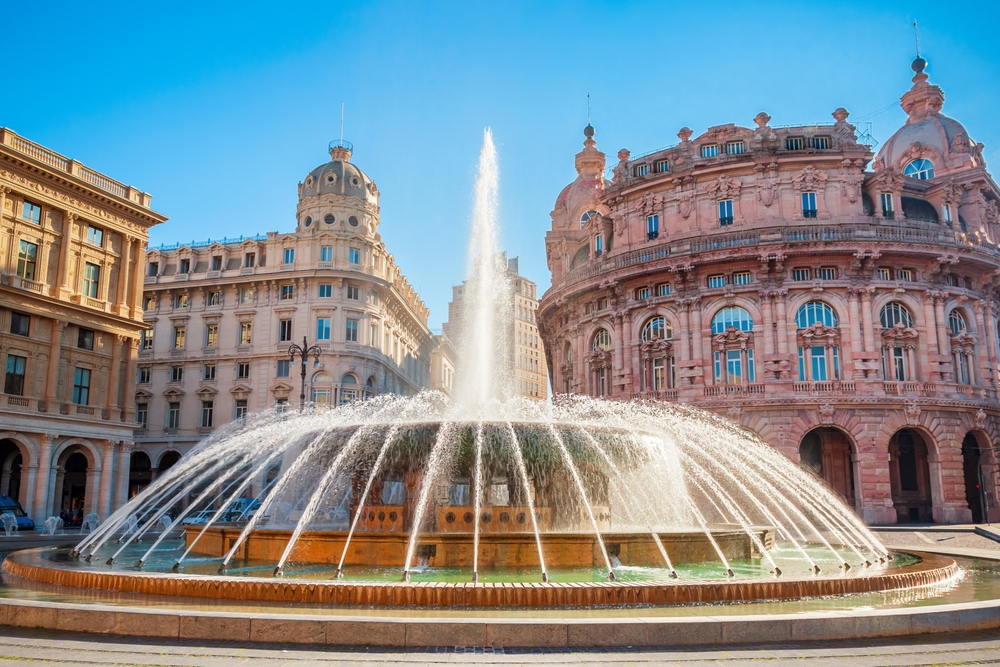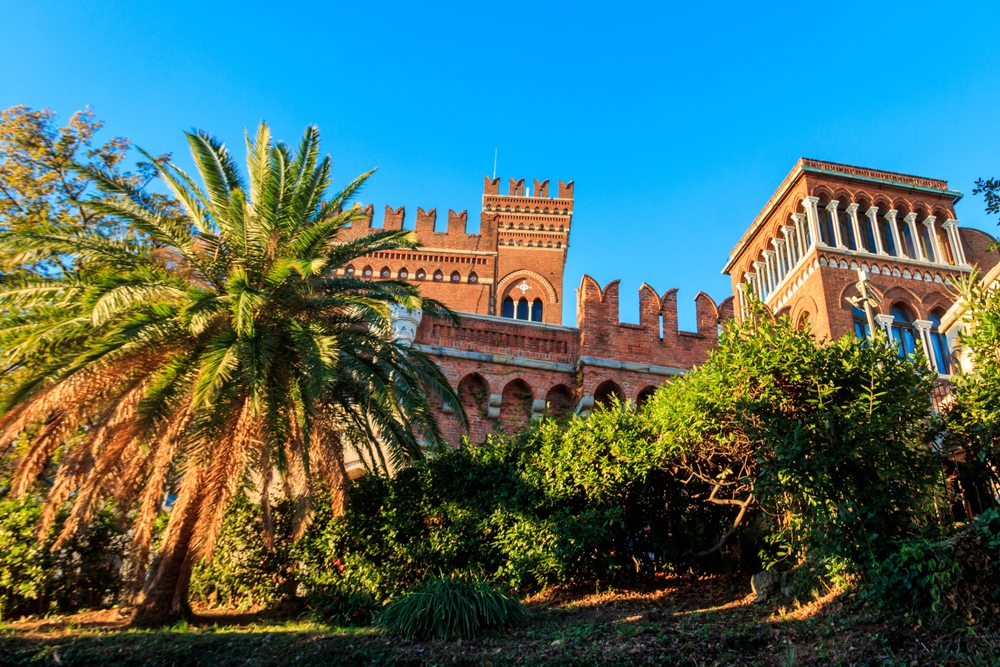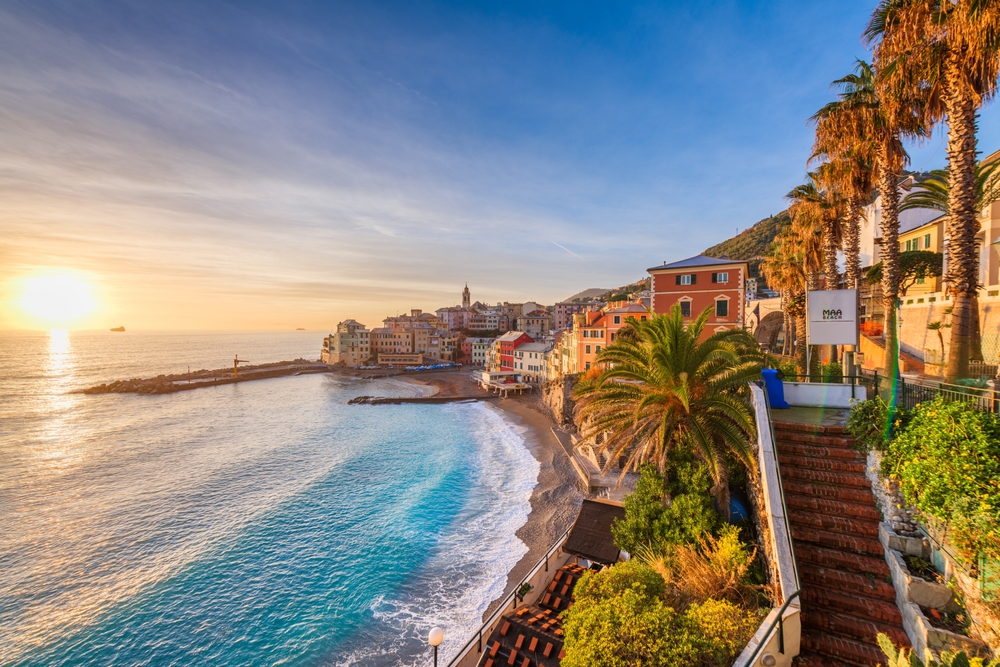Genoa: A complete guide to Genoa
Genoa is one of Italy’s lesser-known holiday destinations. It is often overlooked by tourists in favour of its better-known neighbour, Milan. Nonetheless, the city is breathtakingly scenic and quintessentially Italian. Visiting it during the peak summer months can also be a great way to escape the crowds of Italy’s larger cities. Genoa’s history dates back to the ancient Romans, but hit its heyday from the 11th century onwards. This is when the city was of vital importance as a trading port and maritime power. The city was once the birthplace of Christopher Columbus, thus giving it an even more prestigious reputation within the maritime world. At one point, Genoa’s port was so successful that the city was among one of the richest in the world. Much of the city’s town centre, including the decadent Palazzi dei Rolli, was listed as a UNESCO World Heritage Site in 2006. The city itself is the perfect size to explore during a weekend getaway. Or it can even be the starting location for a longer trip given the city’s proximity to both the Italian lakes and Northern Tuscany. In this guide, we’ll give you all you need to know about this amazing city.
How to get to Genoa
Genoa, whilst smaller in population than many of Italy’s other major cities, is remarkably well connected. Genoa airport connects the city with other major European hubs. Plus, it is set to receive a significant upgrade and refurbishment in the next few years, promising more flights to new destinations. Ryanair operate frequent flights between London Stansted and Genoa, with KLM and Lufthansa flying to the city via connections in their respective home countries. If you’re struggling to find flights direct to Genoa, consider flying into Turin, or Milan, which are both just over a two-hour drive away. If you’re already travelling within Italy, or even further afield in mainland Europe, Genoa’s two main train stations have excellent connections to most major cities if you’re willing to make a connection or two. Overall, Genoa is incredibly well connected, and most tourists have no trouble visiting – even on a short timeframe.
Top things to do in Genoa
Go for a stroll around the old harbour
Having recently been revitalised, the Porto Antico (Old Harbour) and is now a hub of activity, filled with restaurants and bars. The Bigo panoramic elevator, Aquarium, and Biosphere (housing a tropical garden), means the harbour is full of life.

It has plenty to offer for everyone – especially for young families with restless kids. We recommend going for a relaxing stroll around the area to take in both the historic buildings. Prepare to be amazed by the modern super yachts that sit in the harbour.
Discover Genoa’s Lighthouse
La Lanterna, the towering monument that overlooks the harbour, is Genoa’s lighthouse. It stands at 76 metres tall. It is one of the world’s oldest functional lighthouses and has been ensuring the safe passage of ships for almost five hundred years. Genoa lighthouse tickets can be easily purchased online, and offer entry to both the lighthouse, and the scenic 800m walking track that overlooks the harbour. Even if history isn’t quite your thing, the view of the surrounding harbour certainly will be. The climb to the top consists of 172 steps, which can be challenging for some. But, we can assure you, the climb is certainly worth it. Views from the top span all the way from the surrounding hills to the expansive Ligurian Sea. Incidentally, if you plan on visiting both the lighthouse and aquarium, you can buy a joint ticket to provide access to both.
Explore the Doge’s Palace
Built in the late 13th century, the Doge’s Palace is undoubtedly one of the most significant buildings in Genoa, both architecturally, and culturally. It was originally constructed to house the Doge of Genoa. However, it has been continuously expanded over the years to create the amalgamation of stylistic designs it is today. Baroque, Renaissance, and Gothic styles can be seen all over the palace. All come together to create a truly unique experience for any cultural enthusiast.

The palace itself is located close to the city’s other main central landmarks, such as the Piazza De Ferrari, and the San Lorenzo Cathedral, making it the perfect stop-off whilst exploring the heart of the city. Tickets can be purchased both online, or in person, with many tickets offering discounted or even included entry to other attractions across the city.
Walk down Via Giuseppe Garibaldi
Arguably Genoa’s most famous street, Via Giuseppe Garibaldi is a cultural delight for any visitor. Lined with grand palaces, the 250m long street is now a UNESCO World Heritage Site, protecting it for generations to come. Having originally been conceptualised in 1550, the street was built as part of an expansion to the North of the city. It was actually constructed in an attempt to allow the city to grow in line with the booming trade port. The project was almost entirely funded by wealthy European families. These families viewed the financial dealings of city as a possible new line of income and wanted to get in on the good fortune. Any visitor to the street truly is spoilt for choice, as tens of unique palaces line the street. Even Charles Dickens wrote about grandeur and immense scale of the area when visiting one Summer.
Visit the museum
Genoa’s Castello d’Albertis is a spectacular building. It is also home to a superb museum. The castle was the creation of Captain Enrico d’Albertis who left it to the city of Genoa in 1932. Enrico travelled across the world in the 19th and 20th centuries.

During the course of his adventures, he amassed a vast array of stories, artefacts and curiosities. These were collected across all five continents and are now on display in the museum.
Nervi Parks
Just a short drive East from Genoa’s historic old harbour lies the Parchi di Nervi (Nervi Parks). This is the perfect place to explore if you’re looking to take a break from the main attractions of the city. Nestled among Genoa’s green and peaceful Nervi neighbourhood, the 92 acres of gardens stretch along the coastline and offer incredible views of the Ligurian Sea. In the centre of the gardens lies Villa Gropallo. This is a grand 16th century villa tucked away in a small palm tree forest. The surrounding grassy fields are the perfect place for a picnic in the summer months, or for a relaxing walk in the Winter.
Go shopping
Genoa is packed with opportunities to expand your wardrobe or to purchase some local delicacies to enjoy with dinner. It’s also possible to enjoy some high-end designer shopping in Genoa. For food lovers, Mercato Orientale is unparalleled in the city. Here you will find a wide selection of fresh meat and vegetables. There are also various restaurants and street food options available if you’re not an aspiring cook! If you’re looking for a new outfit, the Fiumara shopping centre has stores that range from niche high-end designers to more mainstream big-name brands. There truly is something for every budget, and it is very easy to spend an afternoon enjoying the mall’s expansive central atrium. If shopping centres aren’t quite your thing, Genoa’s main shopping street, Via XX Settembre, has plenty to offer. This allows you to combine experiencing Genoa’s stunning historic central streets with a little retail therapy.
What to eat and drink in Genoa
Genoa’s rich maritime history has not only benefitted the bank balances of the city’s more affluent residents. It has also created an incredibly diverse cuisine. The cuisine does rely heavily on seafood given its proximity to the Ligurian coastline, but also incorporates produce from the surrounding countryside. As is the case with a lot of Italy’s best-known dishes, simplicity is key. The Liguria region of Italy, of which Genoa is the capital, is world-renowned for its pesto. The delicious green sauce was originally created in the area. Many of Genoa’s dishes rely on it as an ingredient. Trofie al Pesto, as the name suggests, simply mixes pesto with pasta. Trofie pasta is most commonly used and is short and twisted in style – perfect for holding the delicious green sauce.

Focaccia is also incredibly popular in the city and comes in many styles and variations. This simple flatbread can easily be made, and is often served as either a daytime snack or as an accompaniment to a meal. It can also be served as an aperitivo before dinner. Focaccia di Recco, is endemic to the region, and is rather unique in style. This shares more similarities with a cracker than a bread. Despite its appearance, this style of focaccia is filled with stracchino cheese, giving it a soft, gooey centre that oozes flavour. Focaccia di Recco is rarely found in other parts of Italy, so is a must-try when visiting Genoa.
Thanks to Genoa’s proximity to the Ligurian sea, many of the city’s dishes incorporate fresh seafood into their construction. Fritto Misto is a dish often popular in high-end London restaurants. It comprises vegetables, bait fish, shrimps and squid, all of which are coated in a thin batter and fried. The end result is a delightfully light dish, often served as an appetiser. Restaurants in Genoa, however, often serve a slight variation on the classic Italian dish, adding a small, diamond-shaped item into the mix of vegetables and seafood. This addition is actually created using milk and comes in two forms; latte dolce fritto (sweeter in taste and similar to custard), and latte brusco, which is much thicker and stronger in flavour (similar to a bechamel sauce).
If you’re in a bit of a hurry, one of Genoa’s most loved street foods, farinata, is made using chickpea flour, water, olive oil, and salt. It is served as a snack – often straight out of the oven, when it is said to be at it’s best. The perfect farinata is crispy on the outside, and soft on the inside, with a savoury flavour.
Liguria produces many varieties of wine that perfectly complement the region’s cuisine. Liguria’s two most commonly produced white wines are Vermentino and Pigato. Both are crisp and refreshing in nature. Both are a perfect pairing for the seafood and light pasta dishes commonly found in Genoa. Red wines are slightly less common. Rossese di Dolceacqua is regarded as one of the best thanks to its light colour, and fruity flavour profile.
Getting around Genoa
Genoa’s bus system is arguably the easiest way to get around the city. There is an expansive network that covers the entire city. Buses in the city centre are relatively reliable and frequent. They run from the early morning all the way into the late evening. Genoa also has a trolleybus system, which caters to a smaller area. However this does cover the more touristy locations in the city centre. They can be a quick and fun way to see the centre of the city if you’re on a strict schedule. The trolleybuses are also electric, making them much more eco-friendly than traditional buses.

Genoa does have a limited underground metro system. It consists of just a singular line that is a little over 7km in length. Trains are frequent, however, and the track snakes around the old harbour. This makes it the easiest way to get from one end of the city to the other. Since the start of the year, citizens of Genoa have been able to travel on the metro system free of charge. Unfortunately, tourists and visitors are still required to pay for a fare.
Genoa’s hilly terrain can be rather difficult to traverse at times, even for the locals. Given this, Genoa’s multiple funicular lines are a great way to enjoy the city without breaking a sweat. The Zecca-Righi funicular starts near the Eastern side of Genoa’s old harbour, and climbs up into the surrounding hills. From here it connects to popular hiking trails that offer incredible views over the city. Another popular line, the Sant’Anna funicular, only has two stations but is beloved by Genoans. Opened in 1891, the line has been meticulously maintained. It connects the bustling streets of Portello to the quieter residential district of Sant’Anna. The short ride time is just three minutes. It’s the perfect way to experience the joy of riding on a funicular, without straying too far away from the main attractions of the city.
Is Genoa worth visiting?
In short, yes! Whilst Genoa is significantly less popular than the likes of Venice, Rome, Florence, and Milan, it almost embraces its less touristy nature. It offers a more authentic charm that appeals to a more passionate clientele. Its historic attractions and scenic location give it a unique appeal that only becomes more enticing once you experience the city’s incredible food scene. We suggest taking your time to enjoy Genoa. The city itself can be fully explored in a weekend. But a longer stay allows you to explore the surrounding area and gain a unique appreciation for its long history and cultural significance. In the unlikely event that you become restless whilst staying in the city, the surrounding Liguria region is filled with breath-taking coastal towns. These include Portofino and the five fishing villages that make up Cinque Terre – just leave the flip flops at home! We truly believe that Genoa deserves a prominent spot on your travel bucket list, and hope you enjoy exploring this incredible city just as much as we do. Book your Genoa tours and experiences online ahead of your stay to make the most of your time in the city…. and the ensure you skip the queues!


